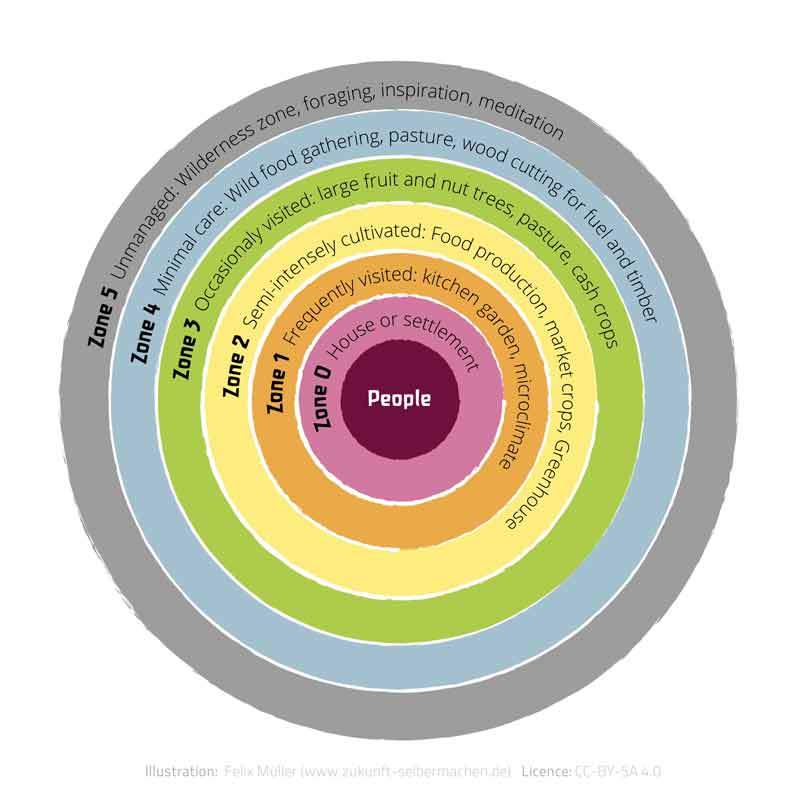Table of Contents
[ad_1]
This article was formerly printed March 22, 2019, and has been updated with new facts.
A method known as “succession” occurs when a person plant species replaces one more.1 As spelled out in the National Geographic quick movie featured higher than, when an region is left to its have units, it will naturally flip into a forest around time, replete with a large wide range of plant species, and this diversification takes place unaided by male.
The film capabilities a gentleman-made “forest yard” made to mimic this type of naturally transpiring ecosystem, where fruit and nut trees increase intermingled with shrubs, herbs, vines and a wide range of perennial vegetables in a seemingly wild-developed setting. According to Countrywide Geographic:2
“U.K.-primarily based Martin Crawford is just one of the pioneers of forest gardening. Setting up out with a flat industry in 1994, his land has been remodeled into a woodland and serves as an academic useful resource for other people intrigued in forest gardening.
This shorter movie by Thomas Regnault focuses on Crawford’s forest backyard garden, which is abundant, assorted, edible and may be one particular response to the potential of food techniques.”
Variety Makes it possible for the Complete System to Prosper
In his unconventional yard, Crawford grows 500 various edible vegetation and trees, still the back garden only involves a couple hours of routine maintenance for each thirty day period. This low maintenance necessity is a immediate result of building a self-sustainable and renewable ecosystem in which anything is working in a symbiotic and supportive trend.
While several currently believe of food items production as the process of planting an once-a-year crop, this actually is just not purely natural, Crawford suggests. In a all-natural ecosystem, there are many layers of plant progress, beginning with tall trees at the leading, with shorter trees, medium and very low shrubs, root crops, climbing plants and lower-lying ground address underneath.
What’s far more, although quite a few of these deliver edible foods directly, other plants, referred to by Crawford as “system vegetation,” are there only to enable the system as a full prosper. In this team you have nitrogen-fixing vegetation, mineral accumulators and vegetation that bring in pollinators and bugs that serve as natural pest handle by feeding on other additional damaging bugs.
Aside from remaining lower-maintenance, this type of diversification also safeguards your crops from all manner of negative climate, be it storms, too much rains or droughts. Even though some may well fail, some others may well gain and do superior, but in quite a few instances, a the vast majority of your crops will endure and do well no make a difference what the climate is executing, Crawford claims.
This can not be mentioned for monocrop farming, wherever if disorders are weak, the entire crop will fall short all at the moment. As these kinds of, possessing a assorted garden is essential to food security. “It provides you utmost resilience,” Crawford claims.
How to Use Regenerative Farming Rules in Your Individual Backyard garden
Around the yrs, I have interviewed numerous pioneers in regenerative agriculture, amid them, Gabe Brown, who has a regenerative farm in Bismarck, North Dakota. As spelled out by Brown, to grow nutritious foodstuff you have to make wholesome soil.
There are five standard rules to building a healthy soil ecosystem, and most of these can be carried out even if all you have is a smaller yard plot in your yard:
|
Prevent disturbing the soil microbiome with tillage, herbicides, pesticides and fungicides — The significantly less mechanical disturbance, the much better. The same applies in your household garden. The a lot more you till, the speedier the soil degrades and is destroyed, as it destroys soil aggregates and mycorrhizal fungi, which homes the microorganisms wanted for nutrient transfer. Equally, by including synthetic nitrogen to the soil, the biology is radically altered — it starts consuming carbon in the soil aggregate, which destroys the soil framework. Without soil structure drinking water cannot infiltrate and shift through the soil profile and be saved via organic matter. The soil aggregates also give the household for soil biology, which is critical to making nutrient dense food stuff. |
|
Defend the soil’s floor with cover crops and address crop residue — Forest and prairie land is entirely covered with vegetation and this is the environment farmers need to have to emulate. That vegetation safeguards the soil not only from wind and h2o erosion, but also from excessive heating and cooling. These residing plants are what close up truly “expanding” topsoil. In your house backyard garden, you can use mulch, wood chips or lawn clippings to do this. You never want to leave soil bare, as bare soil will have a adverse outcome on soil biology and the drinking water cycle. Include crops and other forms of “soil armor,” such as wooden chips, efficiently avert h2o evaporation and lowers the soil temperature. There is easily a 20-degree F change or more involving soil that is bare and soil that is lined. When air temperatures get to 90 levels or so, soil temperatures will rise nicely previously mentioned 100 levels, which will dry all the things out and fry the plants’ roots. “If you have excellent armor or residue on the soil surface, the temperature there can be in the 80-diploma vary. All those plants are expanding. It is a enormous variance in manufacturing for the producer,” Brown says. |
|
Diversify — Having a assorted array of plant existence is crucial, and address crops satisfy this need as properly. Household gardens will also advantage from protect crops, helping to make improvements to the soil, entice helpful bugs and seize extra sunlight (electrical power). |
|
Manage dwelling roots in the floor as lengthy as feasible — In typical farming, the moment a dollars crop is harvested, there is absolutely nothing still left in the area to seize daylight and retain developing. Protecting some kind of growth at all occasions is crucial. If you have a smaller vegetable yard, do not leave it bare after you’ve got harvested your veggies. Rather, plant a address crop in anticipation for the subsequent time. To make the changeover back again from address crop to your picked out greens the subsequent time, avoid the temptation to till the cover crop into the soil. As a substitute, use just one of the following approaches to destroy off the address crop and put together the plot for new crop advancement:
As soon as the cover crop has been killed off, you might be ready to plant your vegetable seeds. For a little backyard garden, use a hoe to portion the deal with crop stays over to the facet. Produce a small slice in the soil, fall in your seeds and deal with with a small total of soil. If you are planting a transplant, basically transfer the address crop apart, dig the hole and plant as normal. |
|
Combine livestock and other animals, which include bugs — Hundreds of years back, significant herds of bison and elk moved across the landscape, foraging, depositing manure and trampling vegetation into the ground. All of this is portion of the organic cycle that is lacking when animals are saved in concentrated animal feeding functions. Several have started off increasing chickens in their backyards once again and chickens are an outstanding addition to a sustainable back garden. Rabbits, pigeons and ducks are other solutions that could do the job in some suburban parts, but even if situation or area guidelines stop you from incorporating animals, be guaranteed to plant flowering vegetation that appeal to pollinators and predator insects, as these will normally aid ward off pests that might otherwise decimate your key crop. |
Guidelines to Help You Style and design Your Possess Permaculture Garden
Even though Crawford refers to his back garden as a “forest back garden,” it is fundamentally a type of permaculture garden. Permaculture epitomizes sustainability by harnessing mutually effective associations to make synergistic, self-supporting ecosystems. Its ideas integrate the most effective of natural and organic, biodynamic and regenerative agriculture. According to the Permaculture Institute:3
“Permaculture is an ecological design process for sustainability in all features of human endeavor. It teaches us how to design and style organic properties and ample foodstuff manufacturing units, regenerate degraded landscapes and ecosystems, create ethical economies and communities and much extra.”
In small, permaculture is an agricultural program in which the areas of the method are all interconnected, working with character as opposed to versus it. The word “permaculture” derives from “long term agriculture” or “long term culture.” The target is not on any a single aspect of the process but on the interactions between them — animals, vegetation, insects, microorganisms, h2o, soil and habitat — and how to use these associations to produce self-supporting ecosystems.
If you want to shoot for a forest garden like Crawford’s, consider his assistance and just start planting some more substantial trees (or include kinds you already have on your house), then add smaller trees, shrubs and plants as you go alongside. You do not have to have it all planned out prior to you start off.
Though there’s no set system for designing a permaculture yard, in this article are a couple of fundamental recommendations to consider:4,5
- Duplicate a forest blueprint with a tree cover that provides way to more compact trees, flanked by shrubs, with scaled-down shade vegetation underneath the cover
- Group vegetation by suitable roots and cover units, and by soil variety, these kinds of as acid fans in 1 place and drought-resistant in a further
- Recognize microclimates in your yard and use them to your benefit, such as cooler shady corners, comprehensive sun, rocky locations and locations that obtain considerable drainage
- Include as considerably diversity as possible, concentrating on indigenous vegetation and animals
- Plan your location in zones centered on use and accessibility for example, plant your herb backyard and greens in the areas least complicated to access, these as along the driveway or together a route close to your deck
Really should you have a big ample piece of land, you could go a step further more and acquire into account the five permaculture zones as illustrated in the subsequent diagram. At its heart are you and your house, but its outermost zone is untamed wilderness.
Zones are structured in a way that maximizes power performance, so routines are sorted by frequency of use, tending, visits and so on. For more comprehensive info about these zones, verify out the Permaculture Exploration Institute’s “Permaculture Zones Primer.”6

[ad_2]
Supply link







More Stories
10 Reader-Favorite Food & Kitchen Hacks
Middletown health official predicts COVID cases will soon rise
There’s a Physician Shortage In the U.S. Here’s Why